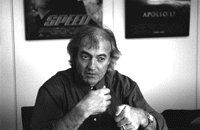 Telepresence as a Design Philosophy
Telepresence as a Design Philosophy
An Interview with William Buxton
Interviewer: MORIYAMA Kazumichi
Translation: YAMADA Kazuko
It's Not Technology, It's Interactive Design
MORIYAMA Kazumichi : Could you begin by telling us how you define the term "telepresence"?
William BUXTON (WB) : First of all, many people think about technology in the sense of interaction between people and machine. But actually I think the most important thing is technology-mediated communication from human to human. So telepresence for me is one of the most interesting research areas. And it's a good idea to be precise about what I mean by "telepresence" because many people have many different meanings for telepresence.
In some places, telepresence is "tele-robotics" or "tele manipulation." While in my work--my experience is in the area of social interaction, i.e., human-to-human interaction, over a distance--telepresence is having a strong sense of presence. But presence of what? It's presence of the person, presence of the activity, presence of the artifacts. To have complete communication, it's important that all of these things are there, both physical and virtual. In this conversation we have already shared many things, but that is very difficult to achieve in, for example, video conferencing.
The second part of what's important for me--and this is where many problems remain--telepresence is not just going across distance in geography, but also in time. So that a person can participate in a meeting even if he cannot be actually there. But the question is, can we go over time, and not just distance, with the same technology? Today you have video conferencing for going across distance and you have maybe VCR for going across time. But they are never integrated and never considered the same problem. Yet in many ways they're the same problem.
Another thing that's very important is that with different professions, such as computer animation compared to automobile design, for example, the artifacts are very different. So you need a very different kind of technology for the conversation, because what must be communicated or scanned or printed is so different. Although we have made some progress in telepresence between two locations, it's very difficult to have multiple people in communication among more than two locations. It's a big problem. But the real problem is that they are being studied as a problem of technology. It's not a technology problem. If my arm gets chopped off, I go to the doctor and get an artificial arm: that is a physical prosthesis. Technology for me is a social prosthesis. If I lose my arm, you have to know what I do with my arm before you make an artificial arm. You need to know what I do--I like to work at my computer, I like to draw. When you know my activities, then you can make a design that fits my needs. Your interests may differ, so a design for you might be very different. I have to understand your activities to design technologies to give you capabilities.
Support via telepresence is also prosthetic: we need to understand the nature of meetings and the nature of interaction. It's not a technology question, but a question of sociology. If we look at most telecommunications companies or people investigating these topics, maybe 80 to 100 percent of the researchers are engineers. In my opinion, that should be at least 50 percent social scientists.
I can draw a figure here. Let's pretend that each of these are people in an organization. In our office here on this floor everybody can tell just by looking who's there. Every time I talk to this person or talk to that person, either by email or telephone, I draw a line. Now, this looks like a telecommunications network but it's actually a social network. If there is much communication, I could make it thick. But I can also make a geographical representation of the social interactions. In fact, there's a mathematics called "graph theory," which studies the properties of this kind of diagram. Every telecommunications engineer knows how.
But if I change from telephones to just people, we forget that we can use the same technique to analyze the flow of information. So here's how I can design a technology to get people in the organization to have the desired structure. While I need the technology to make the design, I also need other knowledge. I must have some notion of "health"--the notion of a healthy sociology.
In many cases, when people make these technologies, even the language they use is the wrong language. They use the word "communication" because they think it's the transfer of information that's important. But the important thing is trust, right? So I call these technologies "trustification," not "communication." It's not in any dictionary; it's my buzz word.

 Next
Next